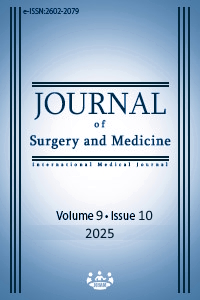Can the probe movement direction affect pain in patients undergoing transrectal ultrasound-guided prostate biopsy?
Probe direction and pain in prostate biopsy
Keywords:
prostate cancer, biopsy, VAS, pain, probe directionAbstract
Background/Aim: Prostate biopsy is the gold standard for prostate cancer diagnosis, but patient discomfort remains a major limitation. While numerous studies have investigated anesthesia and analgesia, the influence of transrectal ultrasound probe movement direction has not yet been examined in clinical studies. This study aimed to evaluate whether the direction of transrectal ultrasound probe movement affects pain perception and complication rates during systematic prostate biopsy.
Methods: In this retrospective cohort study, 246 patients undergoing 12-core transrectal ultrasound-guided biopsy between 2019 and 2025 were analyzed. Patients were stratified into three groups according to the probe movement sequence applied by the performing urologist. Pain was assessed using the visual analogue scale (VAS; 0–10) at five time points: probe insertion, probe manipulation, needle puncture, 30 minutes post-biopsy, and two hours post-biopsy. Complications within 30 days were recorded, including rectal bleeding, hematuria, fever, and urinary retention. Statistical analyses included one-way ANOVA with effect size estimation (η²) for continuous variables and χ² or Fisher’s exact test for categorical variables.
Results: Baseline characteristics and cancer detection rates were comparable across groups. Pain scores during probe manipulation (VAS 2), needle puncture (VAS 3), and 30 minutes post-biopsy (VAS 4) differed significantly among the groups, with Group B reporting the lowest values and Group A the highest (all P<0.001). No significant differences were observed for probe insertion (VAS 1, P=0.30) or two hours post-biopsy (VAS 5, P=0.19). Hematuria occurred in 40–42% of cases, rectal bleeding in 9.6–19.5%, and fever in 2.4–5.2%. Although these differences were not statistically significant (rectal bleeding, P=0.09; fever, P=0.47; hematuria, P=0.94; urinary retention, P=0.86), both rectal bleeding and fever were most frequent in Group A and least frequent in Group B.
Conclusion: Beyond anesthetic technique, probe maneuver direction significantly influences pain perception during transrectal ultrasound-guided biopsy. Group B’s shorter cumulative probe trajectory (≈22–24% reduction) corresponded with consistently lower pain and fewer complications. To our knowledge, this is the first study to identify probe movement strategy as a determinant of biopsy tolerance. Incorporating this approach offers a simple, low-cost modification with potential to improve patient comfort and safety.
Downloads
References
Sung H, Ferlay J, Siegel RL, Laversanne M, Soerjomataram I, Jemal A, et al. Global Cancer Statistics 2020: GLOBOCAN Estimates of Incidence and Mortality Worldwide for 36 Cancers in 185 Countries. CA Cancer J Clin. 2021;71(3):209-49. doi: 10.3322/caac.21660. DOI: https://doi.org/10.3322/caac.21660
Borghesi M, Ahmed H, Nam R, Schaeffer E, Schiavina R, Taneja S, et al. Complications After Systematic, Random, and Image-guided Prostate Biopsy. Eur Urol. 2017;71(3):353-65. doi: 10.1016/j.eururo.2016.08.004. DOI: https://doi.org/10.1016/j.eururo.2016.08.004
Chang SS, Alberts G, Wells N, Smith JA Jr, Cookson MS. Intrarectal lidocaine during transrectal prostate biopsy: results of a prospective double-blind randomized trial. J Urol. 2001;166(6):2178-80. doi: 10.1016/s0022-5347(05)65529-2. DOI: https://doi.org/10.1016/S0022-5347(05)65529-2
Irani J, Fournier F, Bon D, Gremmo E, Doré B, Aubert J. Patient tolerance of transrectal ultrasound-guided biopsy of the prostate. Br J Urol. 1997;79(4):608-10. doi: 10.1046/j.1464-410x.1997.00120.x. DOI: https://doi.org/10.1046/j.1464-410X.1997.00120.x
Nash PA, Bruce JE, Indudhara R, Shinohara K. Transrectal ultrasound guided prostatic nerve blockade eases systematic needle biopsy of the prostate. J Urol. 1996;155(2):607-9. DOI: https://doi.org/10.1016/S0022-5347(01)66464-4
Luscombe CJ, Cooke PW. Pain during prostate biopsy. Lancet. 2004;363(9424):1840-1. doi: 10.1016/S0140-6736(04)16392-7. DOI: https://doi.org/10.1016/S0140-6736(04)16392-7
Mallick S, Humbert M, Braud F, Fofana M, Blanchet P. Local anesthesia before transrectal ultrasound guided prostate biopsy: comparison of 2 methods in a prospective, randomized clinical trial. J Urol. 2004;171(2 Pt 1):730-3. doi: 10.1097/01.ju.0000108125.96072.ff. DOI: https://doi.org/10.1097/01.ju.0000108125.96072.ff
Trucchi A, De Nunzio C, Mariani S, Palleschi G, Miano L, Tubaro A. Local anesthesia reduces pain associated with transrectal prostatic biopsy. A prospective randomized study. Urol Int. 2005;74(3):209-13. doi: 10.1159/000083550. DOI: https://doi.org/10.1159/000083550
Giannarini G, Autorino R, Valent F, Mogorovich A, Manassero F, De Maria M, et al. Combination of perianal-intrarectal lidocaine-prilocaine cream and periprostatic nerve block for pain control during transrectal ultrasound guided prostate biopsy: a randomized, controlled trial. J Urol. 2009;181(2):585-91. doi: 10.1016/j.juro.2008.10.002. DOI: https://doi.org/10.1016/j.juro.2008.10.002
Raber M, Scattoni V, Roscigno M, Dehò F, Briganti A, Salonia A, et al. Topical prilocaine-lidocaine cream combined with peripheral nerve block improves pain control in prostatic biopsy: results from a prospective randomized trial. Eur Urol. 2008;53(5):967-73. doi: 10.1016/j.eururo.2007.09.005. DOI: https://doi.org/10.1016/j.eururo.2007.09.005
Issa MM, Bux S, Chun T, Petros JA, Labadia AJ, Anastasia K, et al. A randomized prospective trial of intrarectal lidocaine for pain control during transrectal prostate biopsy: the Emory University experience. J Urol. 2000;164(2):397-9. DOI: https://doi.org/10.1016/S0022-5347(05)67369-7
Kravchick S, Peled R, Ben-Dor D, Dorfman D, Kesari D, Cytron S. Comparison of different local anesthesia techniques during TRUS-guided biopsies: a prospective pilot study. Urology. 2005;65(1):109-13. doi: 10.1016/j.urology.2004.08.013. DOI: https://doi.org/10.1016/j.urology.2004.08.013
Loeb S, Vellekoop A, Ahmed HU, Catto J, Emberton M, Nam R, et al. Systematic review of complications of prostate biopsy. Eur Urol. 2013;64(6):876-92. doi: 10.1016/j.eururo.2013.05.049. DOI: https://doi.org/10.1016/j.eururo.2013.05.049
Park DS, Hwang JH, Choi DK, Gong IH, Hong YK, Park S, et al. Control of infective complications of transrectal prostate biopsy. Surg Infect (Larchmt). 2014;15(4):431-6. doi: 10.1089/sur.2013.138. DOI: https://doi.org/10.1089/sur.2013.138
Ghafoori M, Shakiba M, Seifmanesh H, Hoseini K. Decrease in infection rate following use of povidone-iodine during transrectal ultrasound guided biopsy of the prostate: a double blind randomized clinical trial. Iran J Radiol. 2012;9(2):67-70. doi: 10.5812/iranjradiol.7561. DOI: https://doi.org/10.5812/iranjradiol.7561
Guo LH, Wu R, Xu HX, Xu JM, Wu J, Wang S, et al. Comparison between Ultrasound Guided Transperineal and Transrectal Prostate Biopsy: A Prospective, Randomized, and Controlled Trial. Sci Rep. 2015;5:16089. doi: 10.1038/srep16089. DOI: https://doi.org/10.1038/srep16089
Lane BR, Zippe CD, Abouassaly R, Schoenfield L, Magi-Galluzzi C, Jones JS. Saturation technique does not decrease cancer detection during followup after initial prostate biopsy. J Urol. 2008;179(5):1746-50. doi: 10.1016/j.juro.2008.01.049. DOI: https://doi.org/10.1016/j.juro.2008.01.049
Downloads
- 232 168
Published
Issue
Section
How to Cite
License
Copyright (c) 2025 Ali Akkoç, Murat Topçuoğlu, Murat Uçar, Erkan Karadağ, Semih Keskin, Deniz Demir
This work is licensed under a Creative Commons Attribution-NonCommercial-NoDerivatives 4.0 International License.
















